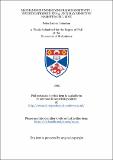Mechanisms underlying radiosensitivity : investigations in XPS-5, an X-ray sensitive hamster cell line
Abstract
The damage caused to cells by ionising radiation is believed to centre on damage to the DNA. In particular, the induction of DNA double strand breaks (DSB) have been implicated in biological end-points such as cell killing and the formation of chromosomal aberrations. The xrs-5 cell line is a mutant Chinese hamster ovary fibroblast (CHO-K1) mutant which exhibits sensitivity to ionising radiation and a number of other DNA damaging agents. This mutation, postulated to involve the hamster homologue of the human XRCC5 gene, is believed to be involved in the repair of the DSB. In addition, there are constitutive differences between the wild type and xrs cells involving the structure and function of the nucleus and higher order chromatin structures. The aims of this thesis were to study further the xrs-5 cell line and its response to DNA damage and to investigate the possible link between chromatin structure and DSB repair. By the examination of the response of xrs-5 cells to a number of DNA damaging agents and potential modulators of this response using the cytokinesis block micronucleus assay [Fenech and Morley, 1985] a possible cell cycle defect was identified in addition to elevated levels of chromosomal damage. Xrs-5 cells appeared to be partially defective in the cell cycle checkpoints involving the passage from G2 phase to mitosis. By the use of a modified neutral filter elution procedure variations in the repair of DSB were observed between xrs-5 and CHO. Conventional neutral filter elution requires harsh lysis conditions to remove higher order chromatin structures which interfere with the elution of DNA containing DSB. By lysing cells with non-ionic detergent in the presence of 2 M NaC1, histone depleted structures which retain the higher order nuclear matrix organisation, including chromatin loops, can be produced. Elution from these structures will only occur if two or more DSB lie within a single looped domain delineated by points of attachment to the nuclear matrix. Repair experiments indicate that in CHO cells repair of DSB in loops containing multiple DSB are repaired with "slow" kinetics (t1/2 = 5 hrs) whilst DSB occurring in loops containing single DSB are repaired with "fast" kinetics (t1/2 " 10 min). Xrs- 5 cells are incapable of repairing these multiply damaged loops. This work indicates that the spatial orientation of DSB in higher order structures of chromatin are a possible factor in the repair of these lesions. By construction of a mathematical model of the process of elution from chromatin loops it was possible to postulate the size of the loops to approximate to 2.5-3 Mbp. Further evidence of a potential structural defect in the chromatin of xrs-5 cells was provided by examination of the polypeptide composition and DNA binding activity of nuclear extracts. The affinity of extracted proteins for double-stranded calf-thymus DNA was measured in nuclear extracts of xrs-5 and CHO cells. There was an alteration in the DNA binding activity of salt extractable proteins from xrs-5 as measured by a filter binding assay. By the use of SDS-PAGE and the technique of South-Western blotting, it was possible to identify the approximate molecular weights of these DNA binding proteins. Differences were found in DNA binding between proteins from CHO and xrs-5 extracts of both non-irradiated and irradiated cells. Two proteins with apparent molecular weights of 32.2 and 31.8 kDa exhibited a lower DNA binding activity in xrs-5 than proteins of similar extracts from CHO. The amount of the 32.2 kDa protein was less in the xrs-5 extracts than in CHO extracts, as measured by Coomassie blue staining. The two proteins have not yet been identified but comprise a major DNA binding activity in CHO extracts obtained by detergent-free extraction procedures. This work provides circumstantial evidence that suggests these two polypeptides may form part of the histone H1 family.
Type
Thesis, PhD Doctor of Philosophy
Collections
Items in the St Andrews Research Repository are protected by copyright, with all rights reserved, unless otherwise indicated.

